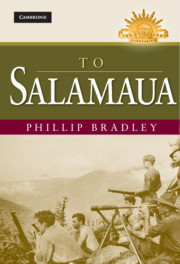Book contents
- Frontmatter
- Contents
- Foreword
- List of illustrations
- Acknowledgements
- Abbreviations
- Introduction
- 1 Death in the Bismarck Sea
- 2 Opposing forces
- 3 Warfe's tigers
- 4 Supply lines
- 5 Mubo stalemate
- 6 On Lababia Ridge
- 7 On Bobdubi Ridge
- 8 Yanks
- 9 Mubo falls
- 10 ‘A bit of a stoush’
- 11 The forbidden mountain
- 12 Roosevelt Ridge
- 13 Old Vickers
- 14 Komiatum Ridge
- 15 Across the Frisco
- 16 Salamaua falls
- Appendix: Place names
- Notes
- Bibliography
- Index
12 - Roosevelt Ridge
Published online by Cambridge University Press: 05 December 2013
- Frontmatter
- Contents
- Foreword
- List of illustrations
- Acknowledgements
- Abbreviations
- Introduction
- 1 Death in the Bismarck Sea
- 2 Opposing forces
- 3 Warfe's tigers
- 4 Supply lines
- 5 Mubo stalemate
- 6 On Lababia Ridge
- 7 On Bobdubi Ridge
- 8 Yanks
- 9 Mubo falls
- 10 ‘A bit of a stoush’
- 11 The forbidden mountain
- 12 Roosevelt Ridge
- 13 Old Vickers
- 14 Komiatum Ridge
- 15 Across the Frisco
- 16 Salamaua falls
- Appendix: Place names
- Notes
- Bibliography
- Index
Summary
On 3 July Herring had met with MacArthur and obtained permission to deploy a second battalion from Colonel MacKechnie's 162nd Regiment to Nassau Bay. Two days later Herring met with Major-General Fuller, the 41st Division commander, to discuss the possibility of moving that second battalion north to Tambu Bay to secure that area for the deployment of artillery. Herring, a former gunner, appreciated that artillery emplaced at Tambu Bay could be used to support the attack on Salamaua.
The 3/162nd Battalion began landing at Nassau Bay on 6 July. The battalion commander was 50-year-old Major Archibald B. Roosevelt, the fourth child of the late US president, Theodore Roosevelt. Serving as a first lieutenant with the US 1st Division during World War I, Major Roosevelt had been thrice wounded and awarded the French Croix de Guerre. Due to his age and his previous discharge with disability, Roosevelt was exempt from active service in World War II, but he had successfully lobbied his cousin, the incumbent US president, Franklin D. Roosevelt, for permission to undertake active service.
On 12 July a separate command, Coane Force, was created to drive north as directed by Herring. Coane Force was commanded by Brigadier-General Ralph W. Coane, the commander of the 41st Division artillery. The 51-year-old Coane had enlisted in the army in 1918, had served in France on active service and after the war had served as an artillery officer in the Californian National Guard.
- Type
- Chapter
- Information
- To Salamaua , pp. 231 - 248Publisher: Cambridge University PressPrint publication year: 2010

